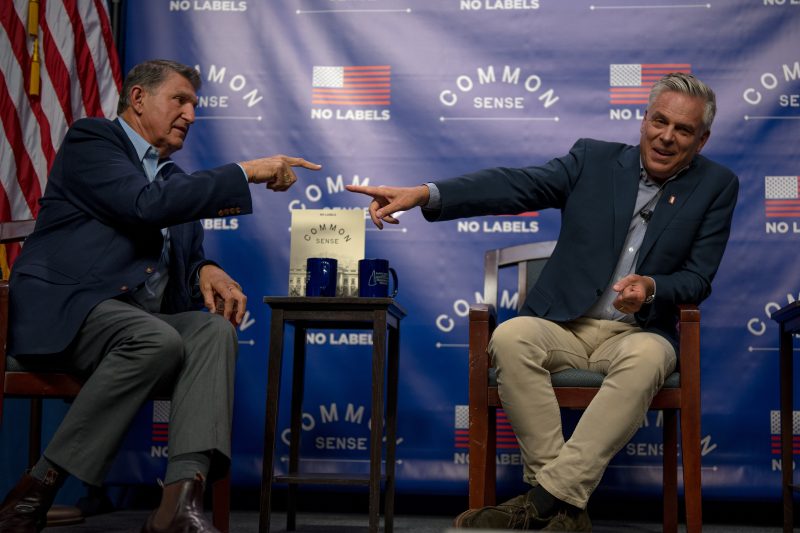
The market for third-party candidates is hot. But who could catch on?
Third-party presidential candidates will most likely never perform the way the 2024 polls suggest they do right now. That’s how these things almost always work, with voters wanting to vote for a winner.
But that doesn’t change the fact that there is an unusually large and potentially consequential market for third-party candidates — one not seen since the 1990s.
So who could actually take advantage of that?
Sen. Joe Manchin III (D-W.Va.) announced Thursday that he won’t seek reelection, while seeming to lean into a presidential run on the No Labels ticket. And you could forgive him for at least thinking there’s an opening.
I wrote two weeks ago about how third-party candidates were polling better than at any point since Ross Perot and his 1992 and 1996 campaigns. And since then, they’ve gobbled up even more support:
A New York Times/Siena College poll of six key battleground states showed Robert F. Kennedy Jr. taking 24 percent in a three-way matchup with President Biden and Donald Trump. He was within about 10 points of both.A Quinnipiac University poll showed Kennedy at 22 percent in a three-way contest. He and fellow independent Cornel West also combined for about 25 percent in a four-way.A CNN poll showed the two of them combining for about 20 percent of the vote.
Perhaps owing to these kinds of polls, we’re seeing a lot of interest. West is running as an independent after entertaining some other routes. Kennedy switched from the Democratic primary to an independent run a month ago. Jill Stein announced another run for the Green Party nomination on Thursday — the same day Manchin did what he did. And fellow potential No Labels candidate and former Maryland governor Larry Hogan (R) greeted Election Day on Tuesday with his own campaign-style video.
Throw in whoever the Libertarian Party’s nominee is, and we could be looking at a very long ballot.
While many Donald Trump critics are convinced that such third-party candidates would merely present potential spoilers for Biden, it doesn’t always break down like that. Kennedy, for instance, is much more attractive to Republicans. So is Manchin. And plenty would depend on which candidates might be compelling to voters.
The most potentially formidable candidate right now would at least seem to be Kennedy. He’s liked by about as many people as dislike him, and he currently polls the best by far in the horserace. But there’s reason to believe that this is inflated because of his famous name. How many Republicans have truly reckoned with his liberal record on things like environmental issues? And how many Democrats and independents know that he’s mostly been notable in recent years as a vaccine critic?
West is largely a blank slate to voters, with the Quinnipiac poll showing 7 in 10 voters unable to rate him. His favorable rating was 12 percent, compared to 18 percent unfavorable. He could seemingly pick off far-left voters disillusioned with Biden on issues like Israel and potentially some Black voters.
We more or less know what Stein’s ceiling is. She got 0.4 percent in 2012 and 1.1 percent in 2016. The best the Green Party has ever done was Ralph Nader’s 2.7 percent in 2000.
Manchin would seem to be a particularly unlikely candidate to truly catch on. While he’s somewhat popular among Republicans, YouGov polling this summer showed his unfavorable rating twice as high as his favorable rating, both overall and among independents. A recent poll from the Public Religion Research Institute showed negative views about four times as high; just 1 in 10 Americans liked him, and only 1 percent had a “very” favorable opinion.
Hogan is less frequently polled. (Years ago, he was a tremendously popular governor in a blue state.) But that PRRI poll at least gives us a sense of how he and Manchin could theoretically perform. Before Kennedy made his switch to independent, it tested both Hogan and Manchin in a four-way race that included West. Each took 10 percent of the vote.
What that poll reinforced, though, is that it could matter significantly which of them might lead the ticket. While both Manchin and Hogan took 10 percent, the two findings were otherwise very different. A race with Manchin showed Biden leading Trump by three points, while a race with Hogan showed Trump up by six. That’s a nine-point difference on the margins.
In other words, it matters who runs and who looks like a potentially viable third-party candidate. Lots of Americans don’t like either Biden or Trump; the big question is who among them is disillusioned enough to actually vote third-party and sees an alternative worthy of that vote.
Judging by the early polls showing a significant appetite for third-party candidates, at least in theory, that’s emerging as one of the most critical questions of 2024.
The third-party candidates probably won’t approach Perot’s 19 percent in 1992 or even his 8 percent from 1996, but that doesn’t mean they won’t matter.
